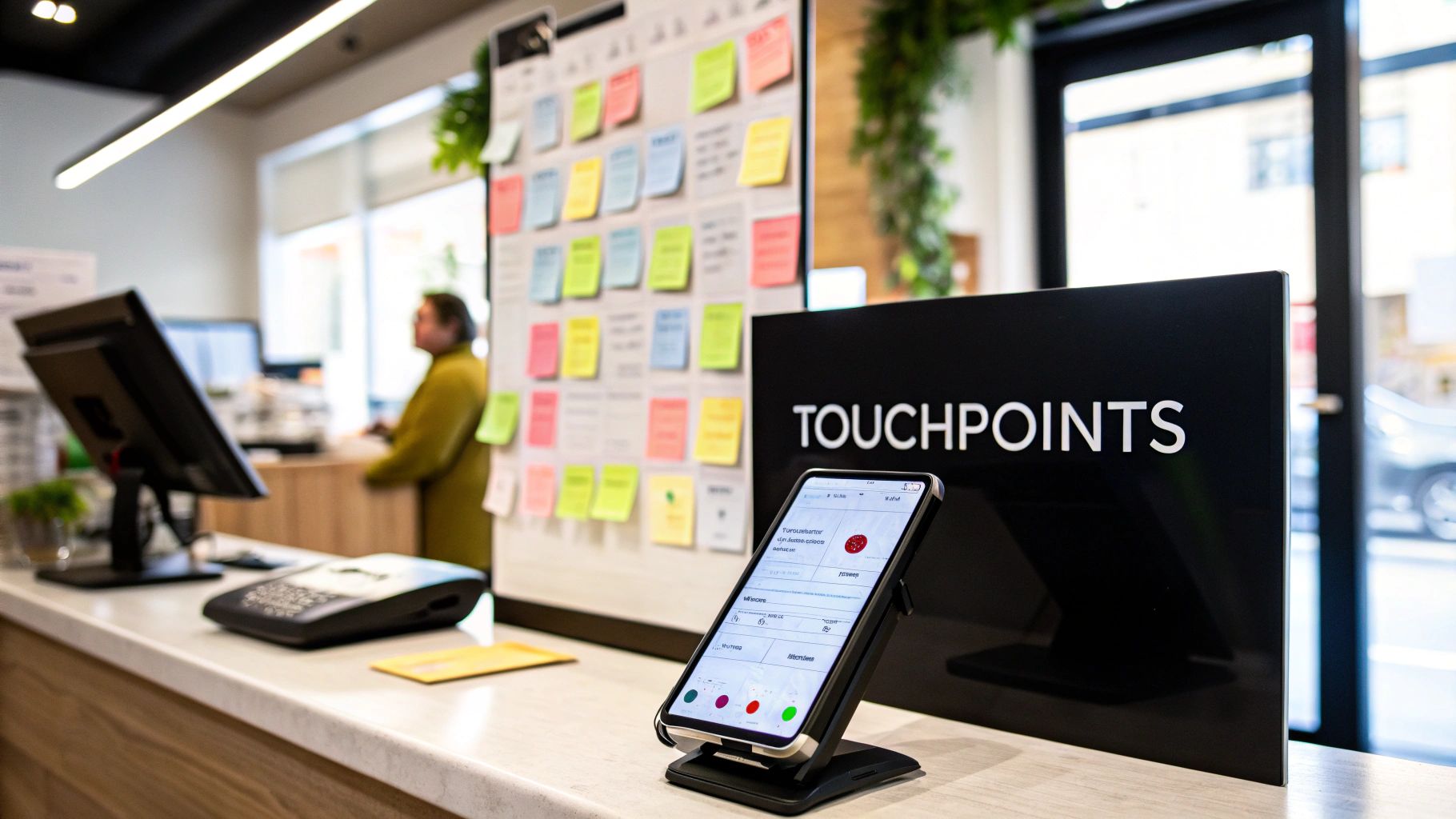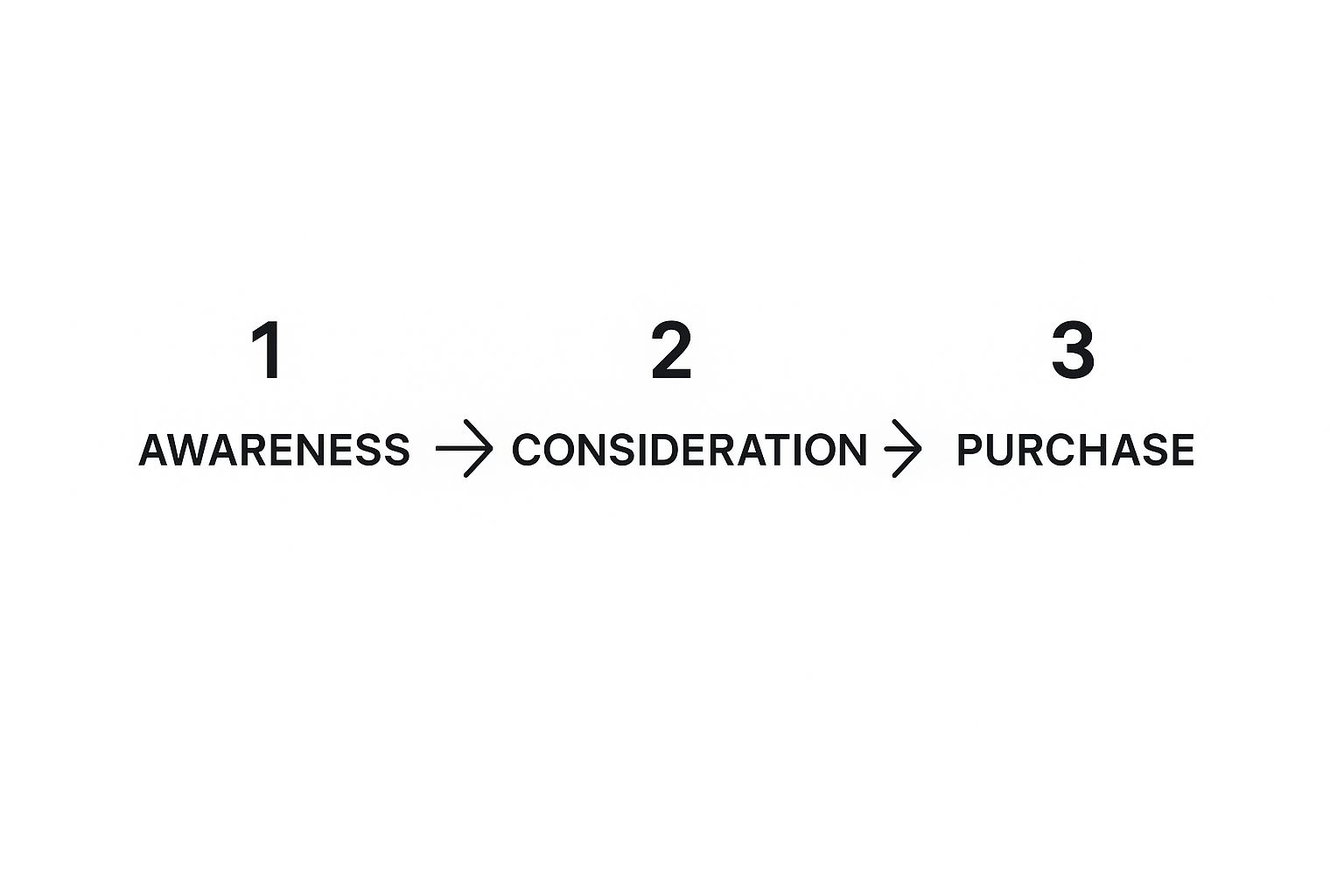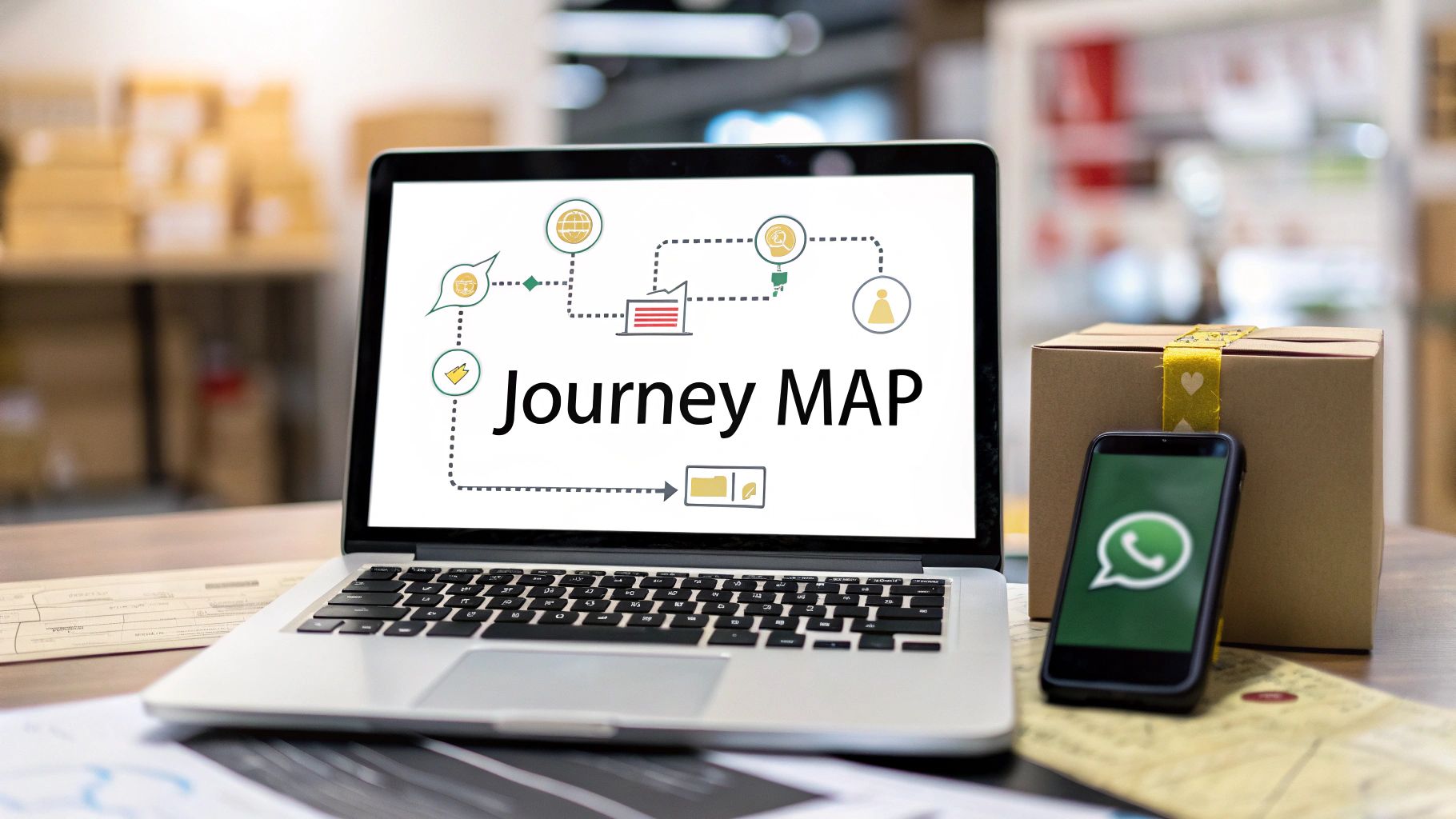You're fighting for every single sale. Margins are tight, competition is fierce, and abandoned carts are a constant headache. We get it. Creating a customer journey map is about stepping into your customer's shoes and seeing your brand exactly as they do. It’s about visualizing every interaction—from the first ad they see to their tenth purchase. This isn't just a marketing exercise; it's a strategic blueprint for turning casual browsers into loyal fans and boosting your bottom line.
In this playbook, you'll learn exactly how to create a customer journey map that finds the leaks in your sales funnel and plugs them with timely, personal communication on WhatsApp.
Why Your E-Commerce Store Needs a Journey Map Now More Than Ever
You’re constantly battling abandoned carts, slim profit margins, and what feels like infinite competition. A common mistake we see is brands treating marketing as separate campaigns instead of one long, connected conversation. This creates a disjointed experience that frustrates customers and loses you sales.
From our experience with over 500 Shopify stores, the brands who consistently win are the ones who obsess over their customer's entire path. A customer journey map isn't just a buzzword. It's how you see your store through your customer's eyes, find the friction points, and proactively fix them.
Key Takeaway: Stop thinking in campaigns and start thinking in conversations. Your customer's journey is a continuous story, and your job is to make every chapter compelling.
From Buzzword to Blueprint
The concept of mapping the customer journey isn't new. It started as a way for businesses to understand how customers felt as they moved between channels. The first step was always defining customer personas based on behavior and demographics. This is still critical today because it helps you pinpoint the exact touchpoints—from a social media ad to a post-purchase WhatsApp message—that define the experience. Recent industry analysis from Markopolo.ai has some great insights on tailoring these paths.
For your e-commerce store, this means getting practical answers to tough questions:
- Where are people finding you? Was it a Meta ad, an influencer's story, or a specific Google search?
- What are their biggest hang-ups? They're wondering, "Is shipping free?", "What's the return policy?", or "Will this actually work for me?"
- Where does the experience get clunky? Maybe it's a confusing checkout page, a slow-loading product image, or a question that goes unanswered for hours.
When you have these answers, you can finally get proactive. Instead of just reacting to abandoned carts, you can anticipate why they happen. Then, you can step in with a helpful message on a channel they actually use, like WhatsApp, which has a 98% open rate.
Ultimately, a good journey map does more than just fix leaks in your sales funnel. It's the foundation for driving repeat purchases and building a brand people care about. When you truly understand the full journey, you can create experiences that directly improve the metrics that matter. To get a better handle on this, check out our guide on how to calculate customer lifetime value—a vital number for any brand focused on long-term growth.
How to Gather the Right Data for Your Map

Let's be honest: a customer journey map built on pure guesswork is little more than wall art. It might look nice, but it won’t move the needle on your sales.
After working with over 500 Shopify stores, we’ve seen firsthand that the most powerful maps are grounded in reality. That means digging into a mix of quantitative data (the what) and qualitative insights (the why).
Start with the Hard Numbers: Quantitative Data
First, let's look at the numbers. Quantitative data gives you the objective truth about what’s happening in your store. It shows you exactly where people are getting stuck, where they're dropping off, and which paths they’re taking.
You already have access to most of this data in the tools you use every day.
Here’s where to look:
- Google Analytics: Your Behavior Flow and Goal Flow reports are your best friends. They visualize the actual paths visitors take. A massive drop-off from a product page to the cart is a huge red flag signaling friction.
- Shopify Reports: Jump into your Sales by channel report. This tells you which sources, like Meta ads or organic search, bring in your best customers (those with the highest AOV, or Average Order Value). Also, look at your site search terms. What are people looking for that they can't find?
- Kanal Analytics: This is where you connect your WhatsApp comms to business results. Check your campaign performance. Which messages get the best open rates and click-through rates (CTR)? This is direct feedback. A high CTR on a "back in stock" notification, for example, is a clear indicator of pent-up demand.
Dig Deeper with Qualitative Insights
Numbers tell you what's happening, but they rarely tell you why. For that, you need to understand the human element—the feelings, motivations, and frustrations of your customers.
A lot of brands skip this part because it feels too time-consuming. It doesn’t have to be.
From our experience: You don't need a massive sample size. We've seen stores uncover major pain points from just 5-10 detailed survey responses or a handful of customer conversations.
Here are a few straightforward ways to collect that essential feedback:
- Run Simple Surveys: Use a tool like Typeform to ask a few smart post-purchase questions. Try asking, "What almost stopped you from completing your purchase today?" or "What was one thing you hoped to find but couldn't?"
- Mine Your Social DMs: Your social media comments and DMs are a goldmine of raw, unfiltered feedback. Pay attention to the questions people ask repeatedly. That’s your audience telling you exactly what’s on their mind.
- Review Your Chat Logs: Go through your support conversations, especially on WhatsApp. Are ten different people asking about your return policy every week? That's a clear signal the information on your site isn't doing its job. This is a perfect opportunity to build a proactive marketing automation flow to address the question before it's even asked.
Building Your Customer Personas and Journey Stages

You can't draw a map if you don't know who's taking the trip. Before outlining touchpoints, you need a crystal-clear picture of your ideal customer. But let's be real—you don't need a ten-page document that gathers dust. A common mistake we see is brands massively overcomplicating this.
Your goal is a simple, one-page persona your team can actually use. Start with the data you have. Look for patterns in demographics, what people are buying, and their direct feedback.
Then, give this persona a name, like "Conscious Chloe" or "Last-Minute Liam." It's a small step, but it instantly makes them feel more real to everyone on your team.
Define Your Key Personas
A great persona is a snapshot that guides your messaging. From our experience, focusing on one or two primary personas is infinitely more effective than trying to be everything to everyone.
For each one, answer these core questions:
- Who are they? (e.g., "Chloe, 28, lives in a major city and is passionate about sustainable living and clean beauty.")
- What is their main goal? (e.g., "She wants to find effective skincare that aligns with her ethical values.")
- What are their biggest frustrations? (e.g., "She can't stand hidden shipping fees and brands that aren't transparent about their ingredients.")
With this simple profile, you can start building a customer journey map that truly speaks to their needs.
The 5 Stages of an E-commerce Journey
Now, let's break down the journey itself. While every customer's path is unique, it almost always follows five predictable stages. Understanding these is the key to knowing when and how to communicate.
Let's walk through a real-world example from a DTC skincare brand we work with, using their "Conscious Chloe" persona.
1. AwarenessThis is the "aha!" moment when Chloe first discovers the brand.
- Her Question: "Is this brand for someone like me?"
- Her Actions: She sees an influencer's Instagram story or a targeted Meta ad about "vegan skincare."
2. ConsiderationIntrigued, she starts digging deeper.
- Her Question: "Do I trust this brand? Will this product solve my problem?"
- Her Actions: She visits the product page, scrolls through reviews, checks ingredients, and might add the serum to her cart.
Expert Insight: This is where a proactive WhatsApp chat is a game-changer. As an official Meta Business Partner, we've seen brands like this use Kanal to add a chat widget to their site. When Chloe hesitates, a pop-up offers to answer her questions about ingredients via WhatsApp. That immediate, personal touch can make all the difference.
3. PurchaseChloe is ready to buy. Your job is to make this frictionless.
- Her Question: "Is this checkout secure? Are there any surprise costs?"
- Her Actions: She enters her payment info and completes the purchase.
4. RetentionThe experience doesn't end at payment. This is where you build loyalty.
- Her Question: "Did I make the right choice? When will my order get here?"
- Her Actions: She receives an order confirmation, gets a shipping notification via WhatsApp, and unboxes her product. A well-timed message checking in can significantly boost her confidence.
5. AdvocacyChloe is now a happy customer and a potential advocate.
- Her Question: "How can I share how much I love this?"
- Her Actions: She leaves a glowing review, recommends the brand to a friend, or shares her new product on social media.
By breaking the journey into these stages, you can pinpoint exactly where to improve communication and remove friction.
To help you visualize this, here’s a quick-reference table.
E-Commerce Customer Journey Stages and Touchpoints
This table outlines the key stages, the customer's goal, and the touchpoints you can influence.
Think of this table as a flexible blueprint. Your specific touchpoints will vary, but the underlying customer goals are remarkably consistent.
Mapping Touchpoints and Finding Opportunities
Alright, you have your personas and journey stages. Now for the most important part: connecting the dots. This is where you map every interaction a customer has with your brand—from a social ad to unboxing their order. This is what separates a pretty map from one that actually grows your revenue.
A common mistake we see is brands focusing only on big moments like the website visit. The real gold is hidden in the small, "in-between" interactions that are often overlooked.
Identifying Your Moments of Truth
Every touchpoint is a chance to impress, but some are "moments of truth"—the make-or-break points where you either win a customer for life or lose them forever.
Here are a few real-world examples from brands we work with at Kanal:
- The Pre-Purchase Question: A customer is on your product page, ready to buy, but has one last question about sizing. If they can't get an answer right now, they're likely to leave.
- The Post-Purchase Wait: The order is placed. The customer is excited. A simple, proactive shipping update via WhatsApp builds on that excitement. Radio silence just creates anxiety.
- The First Use: The package arrives! A quick message with a "pro tip" on how to get the most out of their new product can elevate a good experience into a great one.
This flow chart gives you a solid framework for plotting these interactions.

As you can see, each stage demands different communication from you to keep the momentum going.
Plugging the Gaps with WhatsApp
Once you lay out all your touchpoints, the gaps become glaringly obvious. These are where you're dropping the ball, creating friction, and losing customers.
The strategy that consistently delivers the best results for our clients is this: Identify one or two major friction points and build a targeted, automated WhatsApp flow to fix them. For instance, if you're seeing lots of abandoned carts, a single, well-timed WhatsApp message can recover a surprising percentage of those sales. We've seen clients increase LTV by 20% just by focusing on these moments.
Understanding how customers jump between channels is key. To create a seamless experience, you need a comprehensive omnichannel retail strategy. It’s a crucial piece of the puzzle.
Think about it: your journey map becomes infinitely more powerful when it's backed by instant communication. Research shows that while many customers still call, a staggering 38% of those calls go unanswered. That’s a massive service gap. This is precisely where you can use proactive messaging to get customers the help they need, right when they need it.
By zeroing in on where customers feel stuck, you can introduce support that not only solves a problem but also builds confidence and boosts your bottom line. It’s also the first step in turning satisfied shoppers into genuine brand fans—a cornerstone of any great set of customer loyalty program ideas.
Turning Your Map Into an Actionable Strategy

Here's where the rubber meets the road. A customer journey map is useless if it just collects dust. Its true power is unlocked when it shapes your daily marketing. This is how you transform insights into a high-converting, automated communication strategy.
As an official Meta Business Partner, we know there's no better channel for this than WhatsApp. Your map shows you where to act; a tool like Kanal gives you the how.
Expert Insight: Don't try to fix everything at once. Pick one or two high-impact stages from your map. For most Shopify stores we work with, the Purchase and Retention stages offer the quickest wins. A single, automated flow can have a measurable impact on your revenue in days.
Activating Each Journey Stage with WhatsApp
Let’s get practical. Here are real WhatsApp templates you can build in Kanal to be helpful and proactive at each stage.
Consideration Stage (New Subscriber Welcome):"Hey [Customer Name]! Welcome to the [Your Brand] family. So glad to have you. As a thank you, here's 10% off your first order: WELCOME10. Got any questions about our products? Just reply here!"
Purchase Stage (Cart Recovery):This is where you can make a huge impact. Our most successful clients use a simple, non-pushy reminder. Our cart recovery playbook dives deep into this, but a great starting point is: "Hey [Customer Name], looks like you left something behind! Your cart is saved and waiting. Need any help with your order?"
Retention Stage (Post-Purchase Check-in):"Hi [Customer Name]! Just wanted to make sure you received your order and everything is perfect. We'd love to hear what you think once you've had a chance to try it out. 😊"
From Map to Measurement
Building flows is only half the battle. A recent study highlighted a major hurdle for brands: connecting journey maps to real-time data and proving ROI. You can check out the full report from CX Network to see the data for yourself.
This is why tracking performance is non-negotiable. For every flow you launch based on your map, you must set clear Key Performance Indicators (KPIs).
Here’s how we advise clients to set this up for success:
Assign Ownership: Make someone on your team the champion for each stage. Maybe your marketing manager owns Awareness and Consideration, while your support lead owns Retention and Advocacy. This creates accountability.
Set Stage-Specific KPIs: Your goals are different at each stage, so your measurements should be too.
- Consideration: Track click-through rates (CTR) on your welcome offer.
- Purchase: Monitor recovered revenue and your cart recovery rate.
- Retention: Measure repeat purchase rate and, ultimately, Customer Lifetime Value (LTV).
- Repeat Purchase Rate: Are people who get these messages coming back to buy more often?
- Customer Lifetime Value (LTV): Is the average long-term value of your customers rising?
- Customer Satisfaction (CSAT): Are your customers happier? We wrote a whole guide on how to measure customer satisfaction if you want to dive deeper.
By connecting your journey map directly to these business metrics within Kanal, you elevate it from a theoretical exercise into a living, revenue-generating playbook.
Your Top Questions About Customer Journey Mapping, Answered
After guiding hundreds of e-commerce brands through this process, we've found that a few key questions always pop up. Let's tackle them head-on.
How Often Should I Update My Map?
Think of your customer journey map as a living document, not a "set it and forget it" project. Review it every 6 to 12 months or whenever you make a big business change—like launching a new product line or adding a channel like WhatsApp for customer service.
A Quick Tip from Experience: Don't wait for a big review to fix something that's clearly broken. If you notice in your Kanal analytics that a specific WhatsApp message is falling flat, dive into that part of the map and troubleshoot right away. Small, continuous tweaks drive the biggest wins.
What's the Difference Between a Journey Map and a Sales Funnel?
This is a great question. They sound similar but are completely different.
A sales funnel is all about your company's process. It’s a linear model that tracks how you turn a stranger into a customer (e.g., Awareness > Interest > Decision > Action). The funnel is focused inward, answering, "How do we push people toward a sale?"
A customer journey map, on the other hand, is all about the customer's experience. It’s built from their perspective, capturing their actions, thoughts, and emotions. It’s often messy and non-linear, just like a real person's path. The map looks outward, answering, "What is it actually like to be our customer?"
Simply put, the funnel tracks the what (conversions), while the map uncovers the why behind those conversions.
How Do I Know If My Journey Map Is Actually Working?
Your map's success is measured by the real-world business results it drives. The only way to prove its value is to connect it directly to your Key Performance Indicators (KPIs).
Let's say your map revealed a gap in your post-purchase experience. You decide to build a new WhatsApp follow-up flow using Kanal. To see if it worked, you'd track metrics like:
By tracking these KPIs, you create a direct line between the map and real improvements to your bottom line. To learn how to create a customer journey map that is truly effective, you must be willing to measure, test, and adapt.
Ready to put your map into action and turn insights into revenue? With Kanal, you can build powerful WhatsApp automations that meet your customers exactly where they are, at every stage of their journey.



